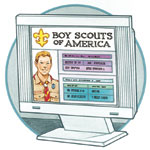
News Briefs
American Indian Scouting Seminar
The 48th American Indian Boy Scouting/Girl Scouting Seminar will be held July 9-13 at the University of Minnesota-Duluth, in Duluth, Minn.
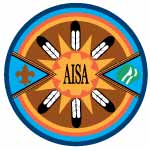
The seminar—designed to teach non-Native Americans about the Native American culture and to teach Native Americans about Scouting—is a great opportunity for councils to gain knowledge and resources for supporting Scouting in the Native American community.
The annual event is conducted by the American Indian Scouting Association (AISA—a joint venture of the Girl Scouts of the USA and the Boy Scouts of America) and hosted by a local tribe or American Indian community. It is attended by tribal and Indian community leaders; Boy Scout and Girl Scout volunteers and staff; American Indian, Native Alaskan, and non-Indian troop leaders in Boy Scouting and Girl Scouting; and 12- to 17-year-old youth registered in Girl Scouting or Boy Scouting.
The event features workshops for adult volunteers and professional staff on Indian culture and Scouting relationships, including organizing Scouting in Indian communities. Youth workshops and programs are also available. Highlights include a parade of traditional clothing, a pow wow with music and dancing, and a visit with the host tribe.
Get registration forms at local Scout council service centers or write Don Rogers, Boy Scouts of America, 1325 W. Walnut Hill Ln., P.O. Box 152079, Irving, TX 75015-2079.
Jamboree regional subcamps will be named to honor famous explorers
A BSA jamboree tradition is for subcamps to be named after celebrity individuals or events related to a special theme or occasion.
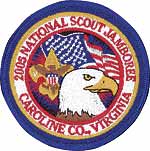
The tradition will continue at the 2005 National Scout Jamboree from July 25 to Aug. 3 at Fort A.P. Hill, Va., where 20 subcamps will be named after famous living explorers.
NORTHEAST REGION SUBCAMPS:
(1) William I. (Bill) Koch, America's Cup winner and longtime supporter of Sea Scouting; (2) Dr. S. Allen Counter, veteran of many scientific studies around the world; (3) Steven W. Squyres, the scientific principal investigator for the Mars Exploration Rover Project; (4) shark researcher Dr. José J. Castro; (5) Dr. Michael J. Manyak, investigator of unknown or undescribed animals throughout the world and medical director of deep-sea explorations.
WESTERN REGION SUBCAMPS:
(6) Distinguished Eagle Scout Steve Fossett, first balloonist to fly solo around the world; (7) Dr. Kenneth Kamler, climber and physician on many Mount Everest expeditions; (8) astronaut and Distinguished Eagle Scout James A. Lovell, member of two Gemini missions and two Apollo missions—and the first man to journey twice to the moon, as command module pilot and navigator on the Apollo 8 lunar landing mission and commander of the Apollo 13 mission; (9) Jim Whittaker, the first American to climb Mount Everest.
CENTRAL REGION SUBCAMPS:
(10) Jim Fowler, longtime host of Mutual of Omaha's "Wild Kingdom" TV program; (11) astronaut Scott Carpenter, who flew the second U.S. manned orbital flight in 1962; (12) James D. Watson, 1962 Nobel Prize winner (with two other scientists) for the discovery of the structure of DNA; (13) Don Walsh, commander of the U.S. Navy bathyscaphe Trieste on its 1960 descent of nearly seven miles into the deepest part of the ocean; (14) Richard C. Wiese, TV journalist, documentary film producer, and youngest president in the 100-year history of The Explorers Club.
SOUTHERN REGION SUBCAMPS:
(15) Dr. Robert D. Ballard, whose deep-sea expedition discovered the R.M.S. Titanic; (16) Richard Wiese Sr., first to fly solo 9,000 miles across the Pacific Ocean from San Francisco to Australia; (17) Dr. Donald C. Johanson, American paleoanthropologist whose 1974 discovery in Ethiopia of a 3.18-million-year-old hominid skeleton "Lucy" greatly advanced the knowledge of early hominid evolution; (18) Dr. William (Doc) Forgey, wilderness medicine expert and adviser to Scouts; (19) Joseph Kittinger Jr., who made high-altitude balloon flights and parachute jumps for the U.S. Air Force in the 1950's; and (20) Will Steger, Arctic preservationist who in 1988 led the 1,600-mile south-north traverse of Greenland, the longest unsupported dogsled expedition in history.
Some campers can meet their campsite's namesake if the honoree happens to be among the many distinguished visitors scheduled to visit the jamboree.
BSA Suggests Ways to Help People and Scouting Groups Affected by the December Tsunami Disaster
In the last week of December 2004, an earthquake and resulting tsunami brought death and destruction to numerous countries in Asia and Africa. On its national Web site, the Boy Scouts of America offered its deepest sympathies to the families and citizens of the countries involved, joining the world "in offering our prayers and support during this very difficult time."
The BSA also noted that several Scouting organizations in those countries had experienced great losses.
For Scouts and their families wanting to help the victims in some way, the BSA suggested the following:
- Support the efforts of disaster relief/housing recovery organizations such as the American Red Cross (www.redcross.org), The Salvation Army (www.salvationarmyusa.org), and Habitat for Humanity International (www.habitat.org). Financial donations can be made directly via the Web sites of these organizations. Local offices of these organizations may provide you with other opportunities for donations of needed items.
- Although the BSA's World Friendship Fund was not established to serve as a disaster relief program, designated contributions can be made for Scout groups affected by the tsunami. Such contributions will be used for restarting and reequipping Scout groups at an appropriate time.
Send a check along with a letter designating the gift to be used for Scout groups affected by the tsunami to: World Friendship Fund, Boy Scouts of America, P.O. Box 152079, 1325 W. Walnut Hill Ln., Irving, TX 75015-2079.
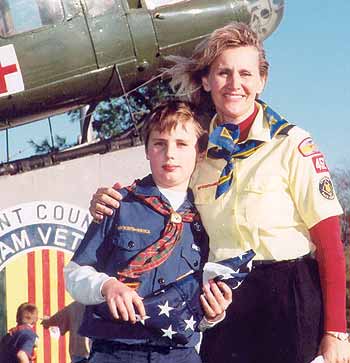 Robby Herbolt and mother, Regina, pose with the U.S. flag presented to the pack. Photograph courtesy of Regina Herbolt. |
A Unique Tribute for Fallen Heroes
By Bill Sloan
An Ohio Cub Scout's inspired idea results in a special memorial for soldiers killed in Iraq and Afghanistan.
One Cub Scout's creative idea—transformed into reality through the efforts of fellow Scouts, their families, and the community—has produced a unique tribute to the more than 1,400 U.S. military personnel killed in the line of duty in Iraq and Afghanistan.
It started in early September 2004 when Robby Herbolt, a fifth grader in suburban Batavia, Ohio, saw a TV news report about the rising American death toll in Iraq.
"Hearing that more than 1,000 soldiers had been killed in the fighting since the war began made a tremendous impression on Robby," recalls his mother, Regina Herbolt, committee chairman of Pack 452 (which, with Troop 452, is chartered to St. Thomas More Catholic Church), in the Dan Beard Council in Cincinnati.
The pack was scheduled to march in a local Veterans Day parade in November, but Robby "wanted to do something more," his mother said.
"Why couldn't we build a [simulated] military cemetery with a cross to honor each of those dead soldiers?" the 10-year-old suggested.
HELP FROM VETERANS GROUPS
At first, Robby's mother thought the project might be too much for a few dozen boys from the pack and troop.
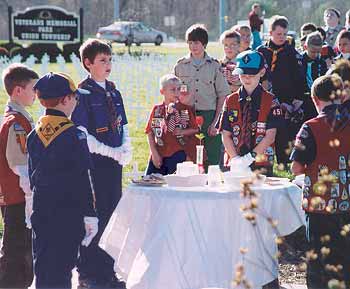 White-gloved Cub Scouts helped in ceremony honoring men listed as missing. Photograph courtesy of Regina Herbolt. |
But, impressed with Robby's enthusiasm, she sought support from local veterans groups, to enable the Scouts to build a simulated cemetery in a large open area at the Union Township Veterans Memorial Park.
President David Murrell of the Vietnam Veterans of America, Chapter 649, agreed to discuss the project with Robby and his mother.
"At the meeting, Robby stood up and did a real selling job," Regina Herbolt reported. "David was impressed, but he made it clear that it would be a big job with a lot of hard work."
And, it turned out, a lot of expense, too. The cost eventually topped $3,000—more than double Pack 452's annual budget. But word spread through the community, and donations of money, materials, time, equipment, and expertise poured in from many sources.
For example, at a local Lowe's store, the projected bill for the wood and other materials needed ran to $1,500—far more than the pack had available. But when the store manager learned what the materials were for, he volunteered to cut the cost in half.
Help came from other sources. Lynn Faulkner, whose wife, Wendy, was among the victims of the Sept. 11, 2001, World Trade Center attacks, lent a trailer to haul the supplies.
Men from the Vietnam Veterans and the Batavia Veterans of Foreign Wars post laid out the cemetery according to military specifications, helped design the 18-inch-high crosses, and provided 1,300 small American flags to adorn the markers.
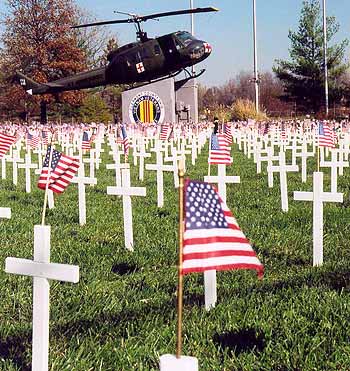 More than 1,300 crosses share the park with a Vietnam-era helicopter memorial. Photograph courtesy of Regina Herbolt. |
Cinergy, the local electric utility, donated floodlights to illuminate the flags at night.
Six Cub Scout parents spent three days cutting the wood, then all 50 Cub Scouts and their families took the pieces home to paint and assemble 30 crosses per boy.
At the park site, Boy Scouts from Troops 452 and 170 joined with the Cub Scouts in a 72-member team that erected the crosses in 36 neat rows.
Later, as the casualties in Iraq mounted, Robby and his mother went to the cemetery each day, adding more crosses and keeping the count up to date.
TOUCHING THE COMMUNITY
"I'm not sure any of us realized how this project was going to touch the entire community," Regina Herbolt said. "In the end, we had more people volunteering to help than we could use."
On Nov. 6, 2004, a large crowd gathered for a memorial service at the cemetery. Among those attending were Lynn Faulkner, the family of Staff Sgt. Charles A. (Chuck) Kiser, who was killed in Iraq, and the family of Spc. Keith M. (Matt) Maupin, who was captured by Iraqi insurgents in April 2004 and remained listed as missing in action. U.S. Congressman Rob Portman presented a flag flown over the U.S. Capitol to the Scouts in appreciation of their efforts.
Although the original plan called for removing the crosses after a three-week period and donating them to Chapter 649 of Vietnam Veterans of America, it was decided to leave them in place until the first free elections are held in Iraq. Cinergy volunteered to leave the floodlights on at night indefinitely.
Meanwhile, Robby Herbolt has been deluged with cards, letters, and personal congratulations for his initiative, and his idea has been celebrated in newspaper articles and TV newscasts.
"I am just totally, totally astounded," David Conley, commander of the VFW Memorial Team of Southwest Ohio, told a Cincinnati Enquirer reporter. "It just amazes me that these children, young as they are, take such an interest in the soldiers who have given their lives for their country."
For Robby, the explanation was simple. "I just wanted to do something to show respect for all the people who died," he said.
Eastern Orthodox Committee on Scouting adds a Scout scholarship
For the past 12 years, the Eastern Orthodox Committee on Scouting (EOCS) has offered a $1,000 scholarship and a $500 scholarship to eligible Boy Scouts or Girl Scouts.
Starting in 2005, the Russian Children's Welfare Society Inc. has funded an additional $1,000 scholarship for a Scout of Russian descent who meets the eligibility requirements.
Applications for the three scholarships are available from EOCS chairman, George N. Boulukos, 862 Guy Lombardo Ave., Freeport, NY 11520, and must be submitted by May 1. Winners will be announced in June.

High adventure bases seek staff
This summer the BSA will hire about 950 people to work at Philmont Scout Ranch, 160 at the Florida Sea Base, and 120 at the Northern Tier bases. Jobs range from crew guide to mountain bike instructor to food server.
Applicants must be physically fit, age 18 (by June 1) or older, and available to work from May 30 to Aug. 22 (from mid-May through Aug. 31 for the Florida Sea Base). Starting salary is based on experience and ranges upward from $790 per month. Lodging and three meals a day are included.
Contact each base for an application and information:
- Philmont Scout Ranch, Seasonal Employment, 17 Deer Run Road, Cimarron, NM 87714, (505) 376-2281, philstaff@philmontscoutranch.org.
- Northern Tier National High Adventure Bases, P.O. Box 509, Ely, MN 55731-0509, (218) 365-4811, info@ntier.org.
- Florida National High Adventure Sea Base, P.O. Drawer 1906, Islamorada, FL 33036, (305) 664-4173, www.bsaseabase.org.
BSA advice for Web sites
As guidance for individuals who operate Web sites on behalf of their Scouting units or to communicate to the public about Scouting, the BSA National Council provides information regarding a few key items pertaining to personal Web sites.
While covering some important concerns, the information is not a comprehensive guide and should not be construed as an authorization for private individuals to operate Web sites on behalf of the Boy Scouts of America. Units and members act as private individuals when communicating with the public.
In addition, the information does not supersede any guidelines or policies a local council has developed for its units. Therefore, unit Webmasters should contact their council for policies and procedures pertaining to the use of the Internet for promoting and supporting Scouting units.
Decorum.
Scouters should exercise propriety and good taste. Remember that the Internet (including Web sites, chat rooms, bulletin boards, and even e-mail messages) is a public medium. Your conduct reflects not only on yourself and your unit but also on the entire Scouting movement whenever the audience knows you are a Scouter.
Personal Safety.
While most Internet users are honest, there is a criminal element that seeks information as a way to gain access to victims. For that reason, be especially careful about providing any personal information, such as names, e-mail addresses, and phone numbers. Always get written permission before posting personal information about adult volunteers (names, e-mail addresses, phone numbers, and the like) and never publish personal information (names, addresses, phone numbers, and so forth) about youth members. If you display or post images of adult or youth members involved in Scouting activities on your Web site, you should first obtain written permission to display their images on the Internet from the adults and from the parents or guardians of any youth member who appears in such images. Sample release forms are available at www.scouting.org/webmasters.
Legal Issues.
Myriad federal and state laws govern publishing in any medium, including the Internet, and cover such topics as copyright infringement, privacy of information, defamation, and more. You should familiarize yourself with these laws so you can ensure that the information you publish doesn't create any legal problems for you or your chartered organization.
Key among these legal issues are (1) never disseminate personal information about youth members over the Internet, and (2) never reproduce or display on your Web sites content from some other source without written permission.
BSA Policies and Procedures.
All policies and procedures that apply to any activity are still in effect when that activity is conducted on the Internet. For example, any online recruiting must be done in accordance with policies and procedures that govern offline recruiting.
These guidelines are posted on the national BSA Web site at www.scouting.org/webmasters. In addition, local councils may require units to meet more detailed guidelines in order for unit sites to be recognized (linked) from the local council Web site.
U.S. military bases will continue to welcome Scouting
In November, as a result of a settlement between the Department of Defense (DoD) and the American Civil Liberties Union (ACLU), all military entities were reminded that they may not sponsor or charter traditional Boy Scout units. In response, the BSA directed local councils to work with the leadership of any unit involved to find an alternative nongovernmental chartering organization, such as a VFW or American Legion post.
The settlement will have no impact on Scouts or their families or on plans for the BSA jamboree this summer. Boy Scouts will be able to use military bases as meeting places and for other functions, such as camping, on the same basis as any other citizen group.
A statement issued by the Department of Justice pointed out that the settlement served to clarify existing Defense Department policy that the "DoD may not, and does not officially sponsor any private, nonfederal organizations, including Boy Scout units."
However, the statement also noted that "Department personnel may continue to be involved with Scouting in their personal capacity. Nothing in the partial settlement agreement is intended to preclude DoD support to the Boy Scouts authorized by DoD policy, to preclude Boy Scout activities on DoD bases and installations, or to preclude DoD personnel in their personal capacity from sponsoring Boy Scout units. . . .
"Provided there is no sponsorship by Department of Defense personnel in an official capacity, Boy Scout units are permitted to meet on military bases and military personnel are permitted to remain active in Boy Scout programs. The settlement does not diminish the level of support provided to the Boy Scouts by DoD’Ķ." For details, see www.bsalegal.org/pentagon-192.htm.
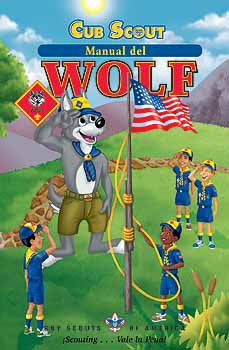
Cub Scout Wolf handbook is now available in Spanish
The BSA Scoutreach Division has added a Spanish version of the Wolf handbook, Cub Scout Manual del Wolf (BSA No. 94-244), to the other available Spanish-language materials, which include the Cub Scout Tiger Cub Handbook (No. 94-219).
Available at no charge, the book can be obtained from local council unit-serving executives.
Share extra copies of Scouting
If your household receives more than one copy of Scouting magazine and you don't need the additional copy, we suggest donating it to one of the following: a neighbor, friend, or co-worker; a school, church, or Scout unit library; a barbershop, hospital, or doctor's or dentist's office; or your workplace reception area.
March - April 2005 Table of Contents
Copyright © 2005 by the Boy Scouts of America. All rights thereunder reserved; anything appearing in Scouting magazine or on its Web site may not be reprinted either wholly or in part without written permission. Because of freedom given authors, opinions may not reflect official concurrence.